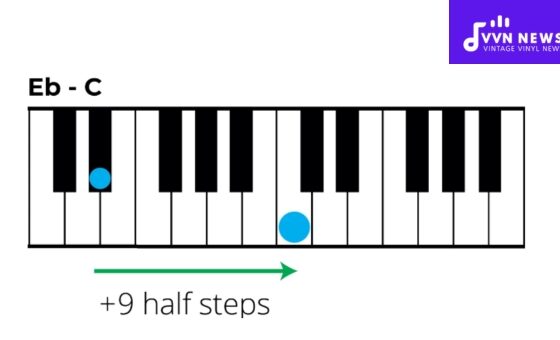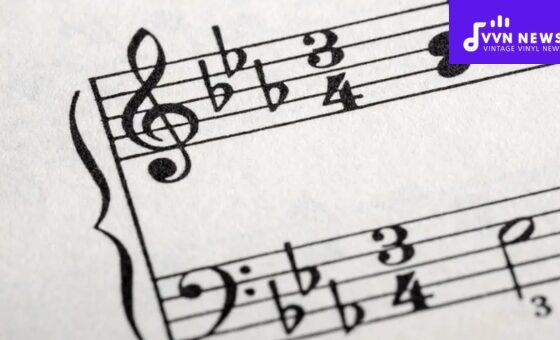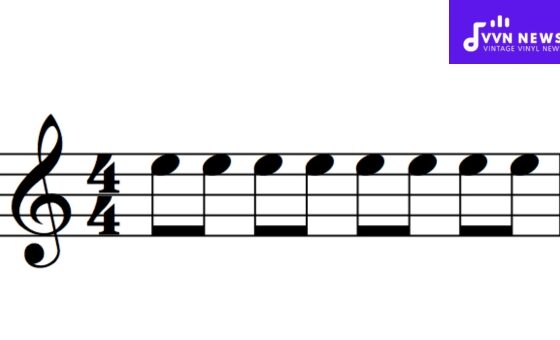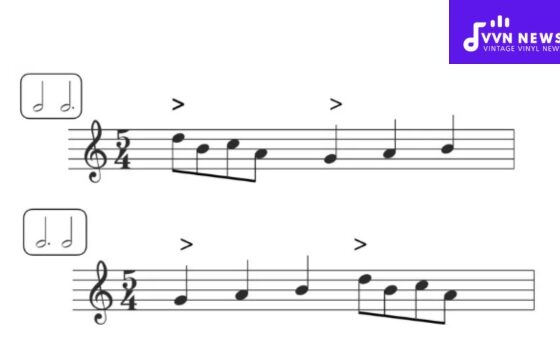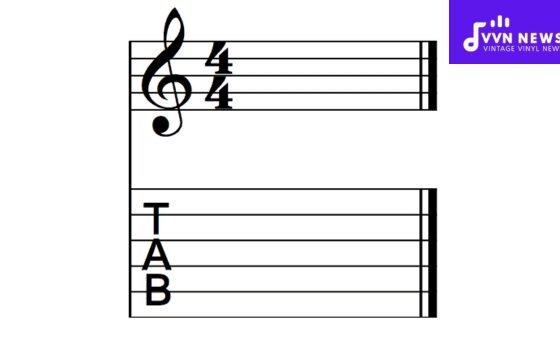Music is a universal language, one that can express every emotion, tell any story, or paint a picture in your mind.
And at the heart of this beautiful language lie the chords – the simple yet powerful combinations of notes that provide rich harmony to melodies.
We’ll focus on a guide to the B flat major triad, an incredibly versatile chord that can add depth and color to your music repertoire.
This fundamental musical element not only enhances your technical knowledge but also gives you a wonderful tool for creativity.
So whether you’re a seasoned musician or just beginning your musical journey, knowing how to play and incorporate the B flat major triad in your compositions can truly elevate your music to new heights.
You don’t need a doctorate in music theory; just an open mind ready for exploration and a passion for great sound!
What is B Flat Major Triad?
The B Flat Major Triad is a three-note chord that consists of the notes B♭, D, and F. It is derived from the B-flat major scale, where these three notes are the first (root), third, and fifth degrees of the scale.
The term “triad” indicates that it is composed of three distinct notes stacked in intervals of thirds.
To understand the B Flat Major Triad better, let’s break it down:
- Root Note: The root note of the triad is B♭. It serves as the foundation of the chord and determines its tonal center.
- Third Note: The third note of the triad is D. In this case, it is called a major third interval because it is four half-steps above the root note. The major third gives the chord its major quality.
- Fifth Note: The fifth note of the triad is F. This interval between the root and fifth is known as a perfect fifth and contributes to the stability and consonance of the chord.
The B Flat Major Triad has a bright and uplifting sound due to its major quality. It finds common usage in various musical genres like classical, jazz, pop, and rock.
Triads form an essential aspect of music theory as they serve as foundational elements for creating harmonies and melodies.
By familiarizing yourself with different triads – like the B Flat Major Triad – you can unlock endless possibilities for composing your music or playing existing songs more effectively.
Also Read: B Flat Minor Pentatonic Scale [Create Emotive Music In Minutes]
What is the difference between B Major And B Flat Major Triad?
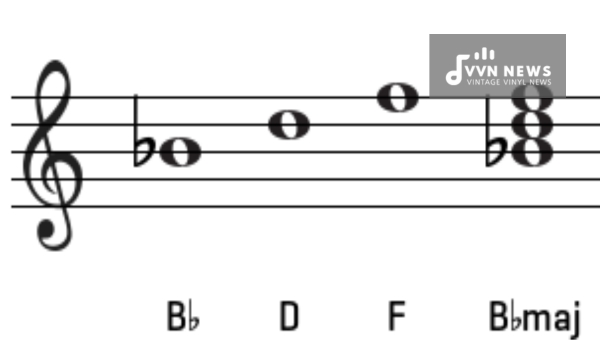
When it comes to the B Major and B Flat Major Triads, it’s important to note that while they may sound similar, they are distinct and unique chords.
Let’s explore their differences to understand their characteristics better.
B Major Triad:
The B Major Triad consists of the notes B, D#, and F#. Here are some key points about the B Major Triad:
- Interval Structure: The intervals between the notes in the B Major Triad are a major third (four half-steps) between the root note (B) and third note (D#), and a minor third (three half-steps) between the third note (D#) and fifth note (F#).
- Key Signature: The B Major Triad is derived from the B major scale, which includes five sharps: F#, C#, G#, D#, and A#. It is often associated with a bright and joyful sound.
- Common Usage: The B Major Triad is commonly used in various musical genres such as classical, jazz, and pop. It can evoke a sense of triumph or grandeur in compositions.
B Flat Major Triad:
The B Flat Major Triad, on the other hand, is formed by using different notes. Let’s look at some key details about the B Flat Major Triad:
- Interval Structure: The intervals in the B Flat Major Triad are a major third (four half-steps) between the root note (B♭) and third note (D), and a minor third (three half-steps) between the third note (D) and fifth note (F).
- Key Signature: The B Flat Major Triad is derived from the B flat major scale, which includes two flats: B♭ and E♭. It has a warm, resonant sound, often associated with jazz and blues genres.
- Common Usage: The B Flat Major Triad is popular in jazz compositions due to its rich and expressive qualities. It can add depth and richness to chord progressions and melodic lines.
The nuances between the B Major and B Flat Major Triads, you can effectively incorporate them into your musical compositions or improvisations, exploring the unique moods they evoke.
Also Read: A Flat Minor Pentatonic Scale [Unleash Subtle Tension In Your Music]
Triads in B Flat Major
When exploring the B Flat Major scale, it’s important to understand the triads that can be built from its notes.
These triads provide a solid foundation for creating chord progressions and harmonies within the key of B Flat Major. Let’s explore each triad in detail:
- B Flat Major (I): This is the tonic triad of the B Flat Major scale. It consists of the notes B♭, D, and F. The B Flat Major chord is often used to establish a sense of stability and resolution in music.
- C Minor (ii): The supertonic triad in the key of B Flat Major is C Minor. It is formed by the notes C, E♭, and G. C Minor adds a melancholic and introspective flavor to compositions.
- D Minor (iii): The mediant triad in B Flat Major is D Minor, comprising the notes D, F, and A♭. This minor chord introduces a sense of tension and anticipation amidst other major chords.
- E♭ Major (IV): Representing the subdominant triad, E♭ Major consists of E♭, G, and B♭. It provides a smooth transition between other chords with its rich and warm tonality.
- F Major (V): F Major serves as the dominant triad within this key signature and comprises F, A, and C. It has a strong presence and often leads to resolving back to the tonic chord.
- G Minor (vi): Playing the role of submediant, G Minor includes G, B♭, and D forming another minor chord with a slight melancholic touch.
- A Diminished (vii°): The leading tone triad in B Flat Major is A Diminished, built with the notes A, C, and E♭. This triad adds tension, often leading to the resolution of the chord progression.
Experiment with different combinations and progressions to add depth and emotion to your musical compositions.
Also Read: D Flat Minor Pentatonic Scale [Spice Up Your Melodies Today]
How to Play B Flat Major Triad on Guitar
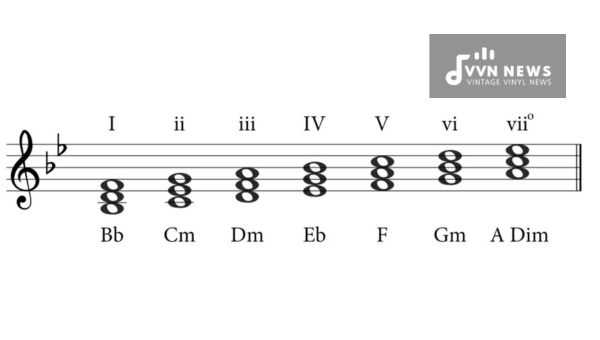
Playing the B Flat Major Triad on guitar requires the proper positioning of your fingers and knowledge of the notes on the fretboard. Follow these steps:
- Finger Placement: Place your index finger on the 1st fret of the A string (which is also known as the Bb note). Your middle finger should be on the 2nd fret of the D string (which is the D note), and your ring finger should be on the 3rd fret of the G string (which is F note).
- Strumming: Once your fingers are in place, use either a pick or your fingers to strum all three strings simultaneously. Aim for a clean sound where each note rings clearly without any muffled or buzzing sounds.
- Practice Tip: To improve your finger strength and dexterity, try switching between different triads and chords in different keys. Practice transitioning smoothly from one chord to another.
How to Play B Flat Major Triad on Piano
Playing the B Flat Major Triad on piano involves Recognizing key placement and hand positioning. Here’s how you can play it:
- Hand Position: Start by placing your right hand over the keyboard with fingers slightly curved, relaxed, and resting on their corresponding starting positions – thumb (T) on B♭, middle finger (2) on D, and pinky finger (5) on F.
- Key Placement: Press down each key simultaneously with their respective fingers: T for B♭, 2 for D, and 5 for F.
- Play Simultaneously: Once all fingers are in position, press down firmly but without excessive force to produce a clean sound from each key.
- Arpeggiate or Strum: You can choose to arpeggiate (play each note individually) or strum all three notes together to create the B Flat Major Triad sound.
Consistent practice is key to mastering any musical skill. Spend time on both guitar and piano, practicing the B Flat Major Triad in various contexts until you can play it effortlessly.
What are B Flat Major Triad Inversions?

Inversion is a term used in music theory to describe rearranging the order of notes within a chord. It allows for different voicings and adds variety to chord progressions.
Now, let’s take a closer look at the inversions of the B Flat Major Triad.
The B Flat Major Triad can be inverted by moving either the root note (B♭), the third note (D), or the fifth note (F) to a higher or lower octave.
By doing so, we create different harmonic structures while still maintaining the essence of the original triad.
Here are the three inversions of the B Flat Major Triad:
- Root Position: In this position, the root note (B♭) is at the bottom, followed by the major third (D) and then the perfect fifth (F). It is denoted as B♭Root.
- First Inversion: In this inversion, we move the root note (B♭) one octave higher, making D the new bass note. The notes are then arranged as D-F-B♭. It is represented as D/B♭.
- Second Inversion: For this inversion, we move both the root note (B♭) and the major third (D) one octave higher, making F the lowest note in the chord structure. The notes are now F-B♭-D. This inversion is indicated as F/B♭.
Each inversion offers its unique sound and voicing options for musicians and composers. By using these inversions, you can add depth and variety to your musical compositions or arrangements.
Also Read: A Flat Diminished Triad [Delve Into Rare Guitar Chords]
Playing B Flat Major Triad Inversions on Guitar and Piano
Playing triad inversions is a great way to explore different voicings and add musical interest to your compositions or arrangements.
Here, we will discuss how to play B Flat Major Triad inversions on both the guitar and piano.
Guitar:
Playing B Flat Major Triad inversions on the guitar involves positioning your fingers in specific fret positions on the strings. Here’s how:
Root Position: Start with the root position of the B Flat Major Triad, which places your fingers as follows:
- Place your first finger on the 1st fret of the A string (B♭ note).
- Your third finger goes on the 3rd fret of the D string (D note).
- Lastly, place your fourth finger on the 3rd fret of the G string (F note).
First Inversion: To play the first inversion of B Flat Major Triad:
- Place your first finger on the 8th fret of the A string (D note).
- Your second finger goes on the 7th fret of the D string (F note).
- Lastly, place your fourth finger on the 10th fret of the G string (B♭ note).
Second Inversion: To play the second inversion:
- Place your first finger barring all strings at the 6th fret.
- Press only A, D, and G strings by barring all three strings with their tips at the same time
- Press E, B, and E strings but don’t sound them.
Piano:
Playing B Flat Major Triad inversions on the piano requires acknowledgment of the notes and finger placements. Here’s how:
Root Position: Start with the root position of the B Flat Major Triad:
- Place your right thumb (1) on B♭, which is two white keys to the left of a group of three black keys.
- Use your middle finger (3) to press D, which is the white key directly above one black key to the right of your thumb.
- Lastly, place your pinky finger (5) on F, which is two white keys to the right of your middle finger.
First Inversion: To play the first inversion of B Flat Major Triad:
- Move your thumb (1) to D, one white key to the right.
- Use your middle finger (2) to press F, one white key above D.
- Lastly, place your pinky finger (5) on B♭, two white keys above F.
Second Inversion: To play the second inversion:
- Move your thumb (1) up to F, which is three white keys to the right.
- Place your index finger (2) on B♭, one white key above F.
- Lastly, use your pinky finger (5) to press D, one octave above where you previously played it.
By familiarizing yourself with these inversions on guitar and piano, you can expand your chordal vocabulary and create more dynamic and interesting musical sounds using the B Flat Major Triad.
Popular Songs in B Flat Major Triad

The B Flat Major Triad, with its bright and uplifting sound, has found its way into numerous popular songs across various genres.
Whether you’re a musician looking to expand your repertoire or simply interested in exploring the musical landscape, here are some notable songs in B Flat Major Triad:
- “Let It Be” by The Beatles – One of The Beatles’ iconic hits, “Let It Be,” features a memorable piano intro centered around the B Flat Major Triad. The triad is played on the piano with the right hand, contributing to the uplifting and inspiring atmosphere of the song.
- “No Woman, No Cry” by Bob Marley – In this reggae classic by Bob Marley, the B Flat Major Triad is prominently featured. The acoustic guitar chords during the verses and chorus are based on this triad shape, adding warm and melodic elements to the song.
- “All of Me” by John Legend – John Legend’s heartfelt ballad “All of Me” heavily relies on the B Flat Major Triad for its emotional resonance. The song begins with arpeggiated piano chords that prominently incorporate this triad.
- “Perfect Symphony” by Ed Sheeran ft. Andrea Bocelli – Collaborating with renowned Italian tenor Andrea Bocelli, Ed Sheeran’s “Perfect Symphony” showcases the beauty of the B Flat Major Triad within an orchestral arrangement. The soaring strings and powerful vocals combine to create a harmonically rich experience.
- “Fireflies” by Owl City – Known for its catchy melody and dreamy electronic soundscape, “Fireflies” employs the B Flat Major Triad throughout its chord progression. This whimsical track captures a sense of nostalgia and wonder.
- “Piano Man” by Billy Joel – Another timeless classic, “Piano Man” by Billy Joel, features the B Flat Major Triad prominently. Piano-driven and filled with storytelling, this song demonstrates how a simple triad can create a memorable and emotive musical experience.
These are just a few examples of popular songs that utilize the B Flat Major Triad. Exploring these songs further and listening closely to the chord progressions will help you develop on how triads are used in different musical contexts.
Also Read: G Flat Minor Triad [Mastering Complex Guitar Chords]
FAQs About the B Flat Major Triad
What is a B flat major triad?
A B flat major triad is a three-note chord that consists of the notes B flat (the root), D (the major third), and F (the perfect fifth).
How do I construct a B flat major triad?
To construct a B flat major triad, start on the note Bb, then go up by 4 half-steps to D, and finally go up by 3 more half-steps to F.
What key signature is B flat major?
The key signature for B flat major has two flats – the notes being, in order, Bb and Eb.
Why is understanding the B flat Major Triad important?
Understanding the B Flat Major Triad helps enhance your music theory knowledge and can add depth to your compositions.
Can I use the B Flat Major Triad in different genres of music?
Absolutely, yes! The versatile nature of a triad means it can effectively be used in various musical genres.
Conclusion
The B Flat Major Triad is a fundamental chord in music theory, consisting of the notes B♭, D, and F. It brings a bright and uplifting sound to compositions and is widely used in various musical genres.
By understanding its structure and learning how to play it on instruments like the guitar and piano, you can expand your musical vocabulary and create harmonies that captivate listeners.
So go ahead, explore the world of triads, and let the B Flat Major Triad inspire your musical journey.




